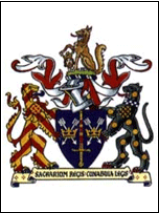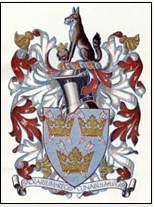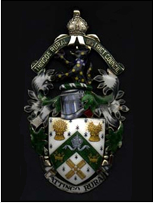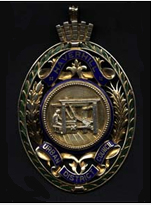Coat of arms
West Suffolk Coat of Arms
In January 2019, the Shadow Council agreed to adopt the former West Suffolk Council Coat of Arms from 1 April 2019. If this is agreed by the College of Arms the new arms will then be designed (drawn) and made available for use.
The Armorial Bearings of the Borough of St Edmundsbury (pictured below) were as a result of the need for a new identity following the re-organisation of local government in 1974. Under the Local Government Act 1972, four local authority areas were combined to become the district of St Edmundsbury with effect from 1 April 1974. These were the:
- Borough of Bury St Edmunds
- Urban District of Haverhill
- Rural District of Clare
- Rural District of Thingoe
 |
| Armorial bearings of the Borough of St Edmundsbury |
On 15 May 1974 the Queen granted a charter conferring borough status upon the new district. The original four local authority areas had their own coat of arms or official badges (pictured below). None of these were appropriate to identify the new Borough of St Edmundsbury.
 |
 |
 |
| Borough of Bury St Edmunds coat of arms, granted in 1606 | Rural District of Thingoe coat of arms, granted in 1958 | Haverhill official badge depicting a loom |
The newly formed St Edmundsbury Borough Council petitioned for a Grant of Armorial Bearings. The arms were designed by the College of Arms. With effect from 13 February 1975 the arms were reserved for the council. Letters patent (the method by which a coat of arms is granted) were granted by the Garter, Clarenceux and Norry and Ulster Kings of Arms on 21 June 1977.
Why have armorial bearings?
The functional purpose of arms is identification. They must be unique in order to identify one particular person or, as in this instance, a local authority and area. Heraldry (the system armorial bearings) is believed to have begun in the period 1130 to 1160. Historically, knights fought wearing steel armour, helmets and carried a shield. As the helmet completely covered their faces they were unrecognisable and so the practice of wearing a distinctive crest that was clearly visible (for example on their helmets or shields) arose.
Later, these crests, designs and mottos were registered by the College of Arms. They were handed down from father to son and became, the crest, arms and motto of the family. The right to bear arms is regarded as being in the nature of a dignity. Like all dignities, arms emanate from the sovereign.
Armorial bearings may be granted to organisations such as local authorities, universities, colleges, hospitals, learned societies, dioceses all of which have an existence recognisable by law. A grant of arms has to be registered by the College of Arms in the same way as arms granted to an individual. The College of Arms uses a complicated system of technical terms to describe a grant of arms so that they can be registered accurately, but in the fewest possible words. Many words derive from Latin or Norman French and go back to Medieval times. This description is known as a blazon.
The blazon (description) of the Borough of St Edmundsbury armorial bearings
This is the modern translation of the blazon (description) of the armorial bearings granted to the Borough Council of St Edmundsbury or you can view the technical blazon and a glossary of terms
Arms
The colour of the shield is blue. In the centre of the shield is the Sword of the St Edmundsbury Borough Council in its natural colours. It has a red velvet scabbard trimmed with gilt ornaments. The spirally twisted grip of the sword is also of gilt. On either side of the sword is an ancient gold crown encircling two silver arrows in the form of an X with their points downwards.
Crest
The wreath is of silver and blue. Above this is a grassy hill on which sits a wolf in profile and natural colour facing left. Its right paw rests on the gold crowned head of a king which has been cut off at the neck. The mantling is coloured red on the outside and silver on the inside. All of this is in turn placed upon a helm appropriate to a corporation - steel, with the visor closed facing the viewers left.
Supporters
On the dexter side (the viewer's left) is a lion on which gold and red inverted V's are superimposed. Its claws and tongue are blue. On the shoulder is a roundel with interlaced lines of red and gold.
On the sinister side (the viewer's right) is a black panther with rows of gold coin-like circles. Around its neck is a collar or band in checks of blue and silver. On the shoulder is a roundel with interlaced lines of gold and black. The tongue and claws are red.
Motto
The Latin: Sacrarium Regis Cunabula legis may be translated as 'Shrine of the King, Cradle of the Law'. This was also the motto of the former Borough of Bury St Edmunds.
What does it mean?
A description of why the Kings of Arms (who design coats of arms) designed the coat of arms the way they did can be read below.
Arms
The possession of a mace or maces was a right granted to Bury St Edmunds by the Charter of Incorporation in 1606. Bury St Edmunds was one of the few towns to be granted the right for a Sword of State in the 17th Century, by Letters Patent of Charles II dated 3 July 1684.
The former corporation's minute book records that on 2 October 1684 thanks were given to Sir Thomas Hervey for the gift of the Mayor's Sword which he presented upon the king creating Bury St Edmunds a 'Mayor Town'. A minute from a meeting on 29 December in the same year recorded that the Mayor shall have the sword and maces carried before him on such days as the maces were formerly carried before the alderman. Although Charles II's charter of 1684 was declared null and void when his brother James II fled the country in 1688, the sword continued to form part of the insignia of the borough. The Charter of 1974 perpetuated the right to have a sword and maces, and to appoint 'local officers of dignity' - Sword and Mace Bearers.
Today the sword and maces are still displayed at meetings of the full council, and are carried during any civic procession. The ancient crowns and crossed arrows were in the arms of the former Borough Council of Bury St Edmunds. They depict the crown of Edmund, the Martyr King of East Anglia from whom the town takes its name; the arrows refer to the manner of his death in 869 at the hands of the Danish invaders for refusing to renounce his Christian faith. Similar crowns are contained in the arms of the diocese of St Edmundsbury and Ipswich and were also included in the arms of the former West Suffolk County Council.
Crest
The crest is of a wolf guarding a crowned head of a king. The grassy mount or hill may be taken as a reference to Haverhill.
Edmund is said to have become king when only a boy in 855. His kingdom roughly corresponded to Norfolk and Suffolk. In 869 the Danes marched on East Anglia and took up their quarters at Thetford.
According to traditional accounts King Edmund went with his army and fought a battle with them but was defeated and captured. The Danes tied him to a tree and shot him to death with arrows. Legend has it that after the Danes had gone the king's subjects returned to bury him and found his body, but the head was missing. Searching for the head they heard a voice in the forest cry out "here I am." Moving towards the voice they saw a wolf standing over the head, as if guarding it. On their approach the wolf disappeared and they took up the head which was afterwards miraculously joined to the body, which was eventually brought to Bury St Edmunds for burial. The story is told in the writings of Abbo of Fleury, a French scholar who died in 1004 so it must have been believed soon after it is said to have happened.
Supporters
To the viewer's left is a gold lion - a royal beast. The chevrons are inspired by the fact that the arms of de Clare, a family from whom the rural district derived its name, included a similar device.
The supporter to the viewer's right is based upon the crest of the former Thingoe Rural District Council and is also included in the arms of the Marquis of Bristol of Ickworth. Each of the supporters has been charged on the shoulder with a roundel on which is a fretty design. These are an allusion to Haverhill - a fret being reminiscent of weaving - an industry which was once carried on in the town to a great extent. The aim here is to include elements from each of the old councils who were joined together in 1974.
Motto
This emphasises the historic importance of Bury St Edmunds. The first part 'Shrine of the King' refers to the burial place of King Edmund, around whose shrine was built the greatest ever Benedictine Abbey. 'Cradle of the Law' refers to the Magna Carta and the legend that the law which gave Englishmen their freedom had its origin at Bury St Edmunds.
The arms and motto of the borough tell us of a thousand years of history in which there is considerable local pride. The arms remind us too, of the four former local authorities that now make up the Borough of St Edmundsbury - the whole area was once the property of the Abbey of St Edmund.
How are the arms used today?
The bearing of arms may be seen as a symbol of power and authority derived from the crown, and perhaps could be seen to represent control and even oppression from above. In the modern state, the power and legitimacy of government and a council mainly derives from the democratic election of its members.
The use of the arms as symbol of the council has changed since 1974, so that by the 1990s it is was solely by the Mayor on his letterhead, and on mayoral occasions. For the normal day to day business of the council, a logo derived from the arms is used. The colours blue and gold are used with the logo to reflect the corporate identity of St Edmundsbury Council. This practice began in 1988. The budget book for 1989 to 1990 was the last one to display the coat of arms. The logo was displayed from 1990 to 1991 onwards.
